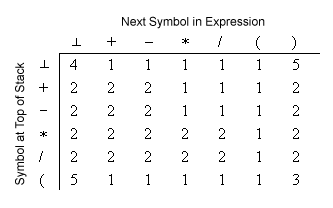For students of computer architecture this postfix notation mini-lecture is really an aside to show you how mind-bogglingly useful the concept of a stack is. It doesn't make any difference whether the stack is implemented in hardware and supported by the microarchitecture or simulated using an array and totally a creation of the high-level language programmer.
At some point in your career you will be asked to write a
program that can interpret an expression in a notation similar to
that of algebra. Getting something like (A+B)/(C-D)
right can seem like a daunting task, especially when you are asked
to write code that will interpret any valid expression. It
turns out to be surprisingly easy if the program is decomposed into
two steps: translation to postfix notation and evaluation of the
postfix notation expression. This is not a new idea... it was described by
Donald Knuth in 1962 [KNUT62] and he was writing a
history!
AB+CD-/ in
postfix notation. (Don't panic! We'll explain this in a moment.)
Postfix notation was introduced by Jan Lukasiewicz (1878-1956), a
Polish logician, mathematician, and philosopher. Lukasiewicz
developed a parenthesis-free prefix notation that came to be called
Polish notation and a postfix notation called reverse Polish
notation, or RPN.
In this mini-lecture we will use variables represented by single
letters and operators represented by single characters. Things are
more complicated in real life. Variables have names composed of
many characters and some operators, like ** for
exponentiation, require more than a single character. However, we
can make these simplifications without loss of generality.
In our simplified examples, each variable is represented by a single letter and each operator by a single character. These are called tokens. In a more complex implementation, your program would still scan a series of tokens, but they would likely be pointers into symbol tables, constant pools, and procedure calls for operators.
Let's do an example using the postfix expression
AB+CD-/. In order to see what's going on as the
expression is evaluated, we will substitute numbers for the
variables. The expression to be evaluated becomes 9 7 + 5 3 -
/. This is equivalent to (9 + 7) / (5 - 3) so
we expect the answer to be eight. Click the "Go" button at the
right to see an animation showing the evaluation of the
expression.
You will see the expression scanned from left to right. A yellow highlight shows the term currently being scanned. The digits in the expression are pushed onto the stack and the operators are performed.
Experiment with the animation until you are sure you understand what's going on.
Now that you see how easy it is to evaluate an expression that's
in RPN form, you will want to convert ordinary infix expressions to
RPN so that you can evaluate them. That turns out to be easy, too,
if you use a stack.
 |
||||||||||||||||||||||||
 |
||||||||||||||||||||||||
(A+B)/(C-D) is
equivalent to the postfix expression AB+CD-/. Let's
convert the former to the latter.
We have to know the rules of operator precedence in order to convert infix to postfix. The operations + and - have the same precedence. Multiplication and division, which we will represent as * and / also have equal precedence, but both have higher precedence than + and -. These are the same rules you learned in high school.
We place a "terminating symbol" ![]() after the infix expression to serve
as a marker that we have reached the end of the expression. We also
push this symbol onto the stack.
after the infix expression to serve
as a marker that we have reached the end of the expression. We also
push this symbol onto the stack.
After that, the expression is processed according to the following rules:
(A+B)/(C-D) is transformed to the postfix expression
AB+CD-/. You can use "reset" and "go" to run the
animation several times.
When an infix expression has been converted to postfix, the variables are in the same order. However, the operators have been reordered so that they are executed in order of precedence.
 |
| Figure 5-21 from [TANE99]. Find the symbol at the top of the stack on the left and the symbol being scanned across the top. The action to take is indicated by the number at the intersection of the row and column. |
Revised: Thu, 13 Mar 2003 02:48:44 GMT
[TANE99] Tanenbaum, Andrew S., Structured Computer Organization, Prentice-Hall, 1999.